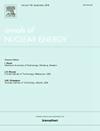Research on energy group structure optimization method for pressure water reactor plate-type fuel based on particle swarm algorithm
IF 1.9
3区 工程技术
Q1 NUCLEAR SCIENCE & TECHNOLOGY
引用次数: 0
Abstract
The energy group structure significantly affects the accuracy and efficiency of cross-section and transport calculations. Plate-type reactors have significant differences in neutron dynamics compared to traditional rod reactors, which means that traditional energy group structures are not suitable for plate-type reactors. Therefore, it is necessary to explore new energy group structures to adapt to the complex structure of plate-type reactor cores. The paper proposes an optimization method suitable for the energy group structure of plate-type fuel based on the particle swarm algorithm. To ensure the universality of the obtained multi group structure in the plate-type fuel structure, the sensitivity of the plate elements parameters has been analyzed. Multiple examples are set up for optimization, with the average difference in k∞ between multi-group and coarse-group transport calculations as the objective function, and the optimal energy group boundary position is sought by updating generation by generation. Based on the above method, the 15-group, 29-group, 37-group, and 45-group structures suitable for multi-group transport calculations of pressurized water reactor plate-type cores are optimized. Numerical verification shows that the group structure proposed in this paper has high computational accuracy for various operating conditions of pressurized water reactor plate-type cores, and significantly improves computational efficiency compared to the traditional 361-group structure.
求助全文
约1分钟内获得全文
求助全文
来源期刊

Annals of Nuclear Energy
工程技术-核科学技术
CiteScore
4.30
自引率
21.10%
发文量
632
审稿时长
7.3 months
期刊介绍:
Annals of Nuclear Energy provides an international medium for the communication of original research, ideas and developments in all areas of the field of nuclear energy science and technology. Its scope embraces nuclear fuel reserves, fuel cycles and cost, materials, processing, system and component technology (fission only), design and optimization, direct conversion of nuclear energy sources, environmental control, reactor physics, heat transfer and fluid dynamics, structural analysis, fuel management, future developments, nuclear fuel and safety, nuclear aerosol, neutron physics, computer technology (both software and hardware), risk assessment, radioactive waste disposal and reactor thermal hydraulics. Papers submitted to Annals need to demonstrate a clear link to nuclear power generation/nuclear engineering. Papers which deal with pure nuclear physics, pure health physics, imaging, or attenuation and shielding properties of concretes and various geological materials are not within the scope of the journal. Also, papers that deal with policy or economics are not within the scope of the journal.
 求助内容:
求助内容: 应助结果提醒方式:
应助结果提醒方式:


